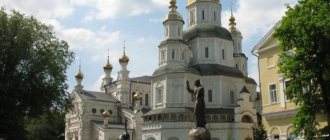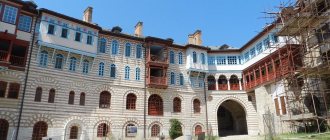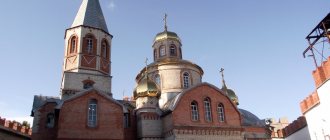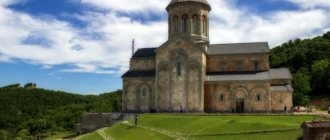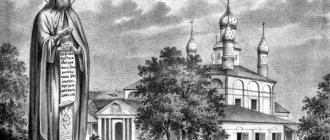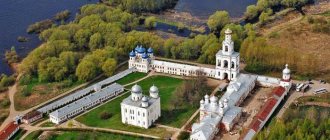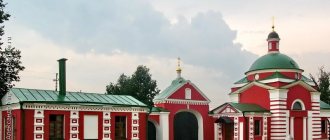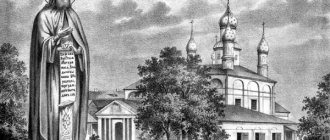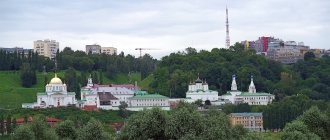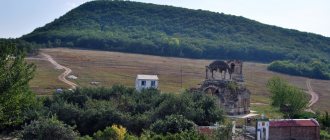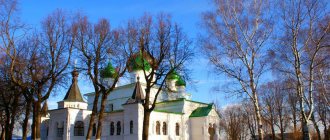Saint Matrona of Moscow is known for her deeds to many, even unchurched people. Believers come to venerate the saint in chapels and churches in Moscow, consecrated in her honor or preserving particles of her relics. For example, the Church of Matrona of Moscow at the intersection of Varshavka and the Moscow Ring Road. They also come to pray to Saint Matronushka at the Dmitrovskoye cemetery, where a chapel was erected over her cenotaph.
Now the saint’s grave is empty, the discovered relics are buried in the Intercession Convent. Thousands of believers come to the Intercession Church of this monastery, standing in a huge line in any weather, for the sake of worshiping the saint and in the hope of a miracle. People call the Intercession Church the Temple of Matrona on Taganka, the name has already taken root, although it is incorrect to call it that way.
History of the monastery
In the fall of 1633, on the day of the Feast of the Intercession of the Virgin Mary, Patriarch Filaret died. He was the father and co-ruler of the Russian Tsar and during his lifetime bore the title “Great Sovereign.” Two years later, Tsar Mikhail Fedorovich, wanting to perpetuate the memory of his parent, founded a new monastery in Moscow.
They began to build the monastery in a cemetery where wanderers and homeless people were buried, and therefore it was called Bozhedomsky or the monastery at Poor Houses. The construction of wooden cells and temples was completed by Mikhail Fedorovich’s son, Alexey Mikhailovich. He invested money received for renting land plots into the monastery, and because of this, the people called the monastery a “room monastery.”
View of the bell tower and cathedrals of the monastery
Like other monasteries in Moscow, at first all the buildings of the monastery were wooden, but in the middle of the 17th century the first stone Intercession Cathedral was built here. Then a three-tiered bell tower and a large brick church in honor of the Resurrection of the Word appeared in the monastery.
During the war with the French, Count Michel Marie Claparède, who was an active participant in the Napoleonic wars and commanded the Polish Corps, settled on the territory of the monastery. The French soldiers did not spare the ancient monastery. They looted all valuables and destroyed some buildings.
View of the monastery from Taganskaya street and the northern gate
In the second half of the 19th century, the monastery was rebuilt, and it received missionary status. An educational institution was created here that trained monks who went on missionary trips. The teachers did an excellent job of their duties, and by the beginning of the last century the monastery was able to train several dozen Christian missionaries.
With the advent of the new government, the fate of the old monastery changed. In 1926, all the monastery churches were closed, the bell tower was blown up, and three years later the Bolsheviks liquidated the monastery itself.
Holy Gate
The large monastery necropolis occupied an area of 5.4 hectares and was considered one of the largest in the city. Many well-born Muscovites were buried in this cemetery - collector Pyotr Shchukin, merchants Khludov, members of the Botkin family, poet and translator Dmitry Glebov and representatives of the Georgian aristocracy. In 1934, at the height of an active anti-religious campaign, the necropolis was razed, and stone tombstones from old graves were sold to everyone as building material. Instead of a cemetery, a cultural and recreation park was built for residents of the area.
For many years, monastery buildings and former churches were used for other purposes. They housed a magazine editorial office, a film studio and a billiard room. Inside the monastery there was a gym and a football field. The Intercession Cathedral was divided by interfloor ceilings, and the building housed a printing house and various departmental organizations.
On the territory of the monastery
The monastery was returned to believers in 1994. At the same time, it was decided to renew the Orthodox women’s monastery in the old place. A year later, the first church service after a long break was held in the Intercession Church. At the very beginning, believers prayed in front of a plywood iconostasis, on which paper reproductions of icons hung. In 1998, the relics of Matrona of Moscow were transferred from the Danilovsky cemetery to the monastery, and the monastery became a place of mass pilgrimage.
Miracles performed by Matrona during her lifetime
Saint Matrona healed people by touching and reading prayers over water. She predicted the revolution in Russia, the Great Patriotic War. People say that during her life and even after her death she performed many miracles.
One day the relatives of a seriously ill man came to Matrona. He could not walk and had difficulty recognizing his loved ones. People with tears in their eyes asked the old woman to help. She ordered the patient to get up early in the morning and crawl to her on his own, without outside help. Of course, people were very surprised and began to be indignant: how could a disabled person crawl to her from another village?!
They left, but Matrona’s words were conveyed to him. The man got up in the morning and crawled along the road. Gradually he stood up and, without outside help, walked to Matrona’s house on his own feet.
There were a lot of such cases. People began to come from other villages to venerate the blessed one. She was thanked for her help with the products that Matrona fed her family.
Saint Matrona
Revered by believers, the saint was born in 1881 in one of the villages of the Tula province, and died at the age of 71 in Skhodnya, near Moscow. Matrona Dmitrievna Nikonova was blind from birth. Her parents, simple peasants, initially wanted to leave the child in an orphanage, but then changed their minds.
Church of the Intercession of the Blessed Virgin Mary
The girl grew up devout and had a healing gift. The wife of a local landowner often took her on pilgrimage trips, so Matrona was able to “see” many holy places and famous Russian monasteries. After the revolution, the woman and her friend moved to Moscow. Here Matrona, like other believers, suffered a lot of harassment from the authorities, however, she managed to avoid arrest.
Every day up to 40 people came to the blessed one’s house, wanting advice and healing. For several years Matrona lived on Arbat, and in 1950 she moved to distant relatives in Skhodnya. When the healer died, she was buried in the cemetery of the Danilovsky Monastery.
Church of the Resurrection of the Word
After the relics of the blessed one were transferred to the Intercession Monastery, an Orthodox chapel was built over the former grave. Matrona is considered one of the most revered Russian saints, and several churches located in different cities of the country are dedicated to her.
Mother Matrona and the Monastery of the Intercession of the Blessed Virgin Mary
Mother Matrona is the most revered saint. A well-known prayer book and ascetic for the glory of God throughout the world, she is an example of miracles and spiritual deeds that were performed in the name of humility, love, and compassion. The main periods of my mother’s wandering life were during the war era. The great image still helps a large number of people; people come to icons and faces for support. Countless numbers of believers come to the Intercession Convent and the number of pilgrims is only increasing.
General information, life
The prayers of the great blessed one provide help to everyone who turns to her. You can turn to the face of the old woman in sorrows, illnesses, for protection and for many other reasons. Another affectionate name for the shrine is Matronushka. The righteous woman was born in a rather turbulent time. This was the turn of the 19th and 20th centuries. An ordinary peasant family lived in the Tula region. She did not live richly.
Due to a lack of means of subsistence, they wanted to send the girl to an orphanage. But at the last moment the stepmother changed her mind. The child was born without eyes, but she looked at the world in a special way, using her inner gaze. The child independently coped with everyday, household responsibilities. The girl was characterized by a cheerful attitude. One got the impression that she knew much more than others - something unknown.
One event testifies to the fact that the girl was chosen by God. During the baptism, the baby was lowered into the font. During the sacrament, a light, fragrant smoke emanated from the baby. The priest said that this child is holy. Despite her blindness, the girl traveled to many holy places. A large number of trips were made thanks to her friend Lydia, who constantly took her with her in the post-revolutionary period.
The image of the shrine is recognized throughout the world. He is always presented in adulthood and with his eyes closed. The righteous woman is dressed in a green tunic and a white scarf. The image exists in two variations - waist-length and full-length. There is a rosary in the left hand. Individual icons are presented with the image of the Mother of God in hand. This is a symbol of the fact that the woman devoted a considerable part of her life to prayers. The right hand has an open palm and is aimed at the worshipers. This arrangement of the palm acts as a sign of truthfulness and kindness. In the background, as a rule, a church is written. Often the image is presented simply against a gilded background.
Mother's help is great. They said that during her life she was distinguished by her resourcefulness and had the ability to work miracles. The power of the face is still being confirmed. Thus, infertile people have the opportunity to give birth to a child, financial issues improve in the absence of money, many ailments go away, and the meaning of life is gained. The image has a great response to heartfelt requests. In order to ask her for help, you can turn to any saint. If possible, it is advisable to arrive in Moscow and visit the monastery.
Monastery Plan
The monastery occupies a fairly large area and consists of a large number of objects. Previously, this was a sparsely populated area. Today there is a large crowd of people here. Address - st. Taganskaya 58.
Church of the Blessed Virgin Mary of the Intercession
The building is located on a hill - Lyshchekovaya Hill. The lighting was done on a holiday, Intercession. The foundation date was 1965. Construction lasted until 1696. The temple is an excellent example of stone architecture. The exterior design features mascarons (a spectacular sculpture made in the shape of a human head from the front). The place is protected. In the past, many invasions swept over it - the attacks of Napoleon, the Great Patriotic War. Today services are held every day. There is a Sunday school and a youth club. The interior decoration is rich and made by restorers of the Tretyakov Gallery. Today the rector is Vladimir Rigin.
Church of the Resurrection of the Word
It is a compact building located in Bryusov Lane. Despite its small size, the temple stands out from others - high domes, luxurious facade decoration, elegant and discreet interior decoration. The final construction was completed in 1634. During the repressions, unique historical bells disappeared. The majestic ringing became possible only on February 18, 2008. On this day, the leading bell “Archangel Michael” was illuminated. The main asset of the temple is the icon of Spyridon. People turn to her to gain spiritual strength.
Bell tower
She deserves special attention. Consists of three tiers. The date of construction is 1790. The design was made in that period with the presence of bells and clocks of the German style. It was made of stone. In 1926 it was subjected to an explosion. Patriarch of Moscow and All Rus' Alexy II completed the illumination of the future stone of the new shrine. All work was carried out at the Tutaevsky Bell Factory. The result of the work is a durable structure, characterized by incredible euphony. The lighting process takes place on October 4, 2002.
Water Chapel
This is the holy spring of the nunnery. It was created in 2005. The lighting process was carried out by the Patriarch of Moscow. Today, containers with holy water are taken away from here by pilgrims. If desired, all the necessary containers can be purchased at a local store.
holy gate
Such a landmark as the holy gates has survived to this day. Their erection was made in honor of the holiday - Intercession. The construction of the structure was carried out in tribute to the memory of Mikhail Feodorovich. This was the grandfather of Patriarch Filaret. The date of his death falls on the Intercession of the Mother of God. If you look far into history, you can find information that this territory served as a cemetery for the unfortunate and homeless. The dead were brought from various metropolitan areas (17th century). Here they found their last refuge - the “poor women”. This is what the “bloody lands” in Jerusalem were called.
Walls and towers of the fence (XIX-XXI centuries), gates from the north
Driving past the shrine, your gaze will certainly be drawn to the bright red walls and the bell tower flaunting in the distance. On the western side, the walls, unfortunately, have not survived. There are also no nineteenth-century gates. The construction of the area from the south was carried out according to the project of V.N. Karneev. It looks majestic and elegant.
In addition, integral elements of the ensemble are the abbot's cell, the abbot's building, the entrance gate, and the clergy's house.
Properties of the Intercession Monastery
Necropolis of the Intercession Convent
The necropolis is one of the largest in the capital. Information about the cemetery has reached our time since 1606. The formation of the necropolis began in the 1650s. The burial is located on the western side. A significant proportion of those buried here are famous personalities (nobles and merchants). Thus, it is a unique historical and memorial value and the leading tomb of the merchants. Representatives of the spiritual forces of Georgia rest in this place. The Botkins, Khludovs, P.I. are buried here. Shchukin, Eminence Dionysius (founder of the language of Yakutia). Note that the impressive territory was subject to demolition. Later, a park was built on the site.
Holy spring of the Intercession Monastery
The attraction appeared in 2005 and was illuminated by the Patriarch of Moscow and All Rus'. Believers from the most remote corners of the planet come here for healing water. Matronushka spoke about her miracles.
Relics of the Holy Righteous Matrona of Moscow
The face of the Matrona of Moscow is kept in the capital's Pokrovsky Monastery. There is also an ark with relics here. The shrines are decorated with numerous flowers brought by parishioners. It is customary to dry the plants and then store them at home and add them to drinks for healing. The main point of all pilgrims is visiting this attraction.
The relics were placed in the temple in 1998. They lie in a tomb made of silver. Access is open every day. Anyone can come here from morning until nightfall. They come to the face with a wide variety of requests - some to thank, and others to ask for help. Believers believe that in order to ask the righteous woman for help, it is enough to come to any image of Orthodoxy. A native of the Tula Province prays for souls before God.
The Russian intercessor has always been a symbol of protection. All those who really need spiritual support receive it. The reliquary with parts of the relics is transported every year to Russian settlements for veneration.
The Russian land is famous for the presence of a large number of healers. Many of them, the field of death, acquired the status of a saint. Matrona is an extraordinary person who has an amazing gift. The girl had no eyes at all. The eyeballs were completely covered by the eyelids. Since childhood, the child spent a lot of time in the Church of the Assumption of the Mother of God.
Over time, those around her began to observe that the future soothsayer was familiar with a large number of human vices, knew how to sense the approach of a threat, and read people’s thoughts. With her prayerful power, Matronushka could heal from various diseases. It is noteworthy that her help to people was significantly different from the actions of other righteous people. She did not use spells, magic and other techniques that were not of a Christian nature. The woman did not welcome sorcerers and whisperers. There were always novices next to her. He spent a long period of life in Moscow. I had to wander around different residential buildings and even basements.
Then she received shelter from priest Vasily. In 1940, there was a great prediction - the beginning of the Patriotic War. The healer fought for the fate of the sick and infirm, and had a negative attitude towards deciphering dreams. People went to her from different parts of the Earth - for advice, searching for the meaning of life, finding happiness. The great martyr died on May 2, 1952. Today her grave is a sacred place.
Icon of the Mother of God “Seeking the Lost” in the Intercession Monastery
An image of the Mother of God “Seeking the Lost” was created for the temple. Yes, Matrona insisted. The story is amazing. One day the old woman asked the librarian to find a book called “Recovery of the Lost.” The reader was surprised by the request. The righteous woman decided to paint the icon. Funds were collected by the entire village. Interestingly, the intercessor could identify money that was not donated. They were immediately returned to their owners. The work of painting the face was entrusted to an artist from Epifani. Unfortunately, his name is unknown. At first, nothing worked for him. The author repented of his sins before work, and the process went in a positive direction. When the image was ready, it was carried in a procession to the cathedral in Sebino. Soon, it became recognized as the most important shrine of the area. During drought, it was taken to the fields for prayers, in order to bring rain closer.
Miracles and healings
According to local residents, a wave of miracles associated with the name of the blessed one periodically occurs. The line to see the relics only grows every year. No one leaves without consolation after standing for several hours waiting. The pleaser is one of the “quick to hear.” This is what people call those who quickly answer prayers, asking God for help. These people are turned to in the most difficult situations, when the last hope remains.
Today the monastery has a book of miracles. It describes all the events that occur through the prayers of the healer. There are cases where patients with severe cancer diseases were cured. All information is confirmed by medical histories, which are taken from genuine medical records. Infertile couples gain children, the poor and homeless gain financial well-being. But the most memorable miracle is the profound changes in thoughts and souls that appear after turning to the icon.
According to the stories of one intelligent woman, a considerable number of people with little faith and illiteracy acquired faith. People say that there is something incomprehensible and unknown in the shrine. She is capable of collecting an incredible number of sinful and faith-repulsive individuals in one place. An intelligent woman said that, despite her internal hostility, she still took small steps towards him.
First, she was given a book about the blessed one as a gift. Then, in the temple, where she constantly turned for spiritual support, the face of the great martyr appeared. After a certain period of time, the lady was imbued with the idea that the divine feat is a reflection of Christ’s love. She is not indifferent to everyone, sincerely accepting everyone, without exception.
The story of Praskovya Anosova, who visited her brother in a psychiatric hospital, deserves special attention. The girl says that when she came to see him again, she met a man and his wife on the way. They were on their way to have their daughter discharged from the hospital. On the way back home we met the same fellow travelers. Their daughter started barking on the way. Praskovya suggested taking the mentally ill woman along the way to Matrona of Moscow. The unfortunate woman's father was a general. He categorically did not like this proposal. But at the insistence of his wife, the trip took place. The girl was brought to the blessed one. She turned as if into a stick and began to throw saliva at the old woman and scream. The saint asked not to touch the person, saying that now she would not do anything like that. The girl fell to the floor, began to fall, spin, and then simply fell asleep for three days. She was given proper care. Soon the girl was healed.
Currently, there are quite a lot of similar stories. There are opinions and cases when the healer helped cure ailments when doctors could not help. There are an incredible number of similar coincidences. They are unique. People believe that there is no need to despair, it is important to believe and a miracle will definitely happen.
Predictions
The fortuneteller, blind from birth, was distinguished by the presence of God's gift. Pavel Prokhorov, the priest who baptized her, was the first to mention this information. From an early age people came to the girl for healing. At the age of 17, she was unable to move independently and performed the procedure in a sitting position. She was a harbinger of many dangers, foreshadowed many critical situations, protecting the people.
She predicted the fate of Nicholas II and the beginning of revolutionary actions. So, in 1894, having asked her mother for chicken feathers and having found the largest, she decided to choose a tsar-father. And she was right. When the Russo-Japanese Battle ended, the Russian land came under the power of Nicholas II.
In 1899, a revolution was predicted. The fortuneteller spoke of countless attacks and robberies, the destruction of cathedrals, and the division of territories. In 1917-18 mentioned the long-term division of Russian lands. And in 1903 she noted a deterioration in the quality of life and a reduction in the number of Orthodox Christians. Her prophecy contains words about World War II. The shedding of blood was described several years ago, talking about the great victory of the Russian population.
There is separate information about Gorbachev from the revered. She said that Stalin would initially leave power. Rulers will appear, one worse than the other. Many will scatter to different countries. Mikhail will appear soon. He will want to help the population and change everything. There will be unrest and changes of parties. This is exactly what happened, 1950-1960. - This is a segment of the rule of Gorbachev and Yeltsin.
A lot has also been said about the end of the world. The saint showed compassion for her loved ones, arguing that life would only begin to get worse with each passing century. People will have to make a difficult choice between the cross and bread. The darkest prediction of the 21st century is considered to be the presence of death without war, a significant number of victims.
How to get to the monastery?
organizes excursions to monasteries
Travel from Yoshkar-Ola
Travel from Cheboksary
Travel from Kazan
The address is known to a significant proportion of believers - st. Taganskaya 58. The monastery provides reception regularly from 7 am to 20 pm. You can get to your destination using the Marksistskaya metro station on the Kalinin line. In addition, it is possible to get there from the Proletarskaya station of the Tagansko-Krasnopresnenskaya line. Local residents recommend focusing on the Zvezdochka shopping complex.
You can get to the shrine by buses (106, 51, 74), trolleybuses (16, 63, 26), minibuses (316, 567, 463). The duration of the trip is two stops. From the stop you will need to travel no more than 50 meters.
If you choose the Proletarskaya metro station, the stop will be 100 meters away. You will need to transfer to trolleybus No. 26 or tram No. 46. You need to go to Abelmanovskaya Zastava. Then you need to go another 150 meters.
You can also get there from Ryazansky Prospekt station. But this path is longer; it is necessary to overcome 20 stops. You should get off at the address - Ryazansky Prospekt, 75K3.
conclusions
The Intercession Women's Church is one of the most wonderful treasures of Russia. It features beautiful ancient architecture. Pilgrims come here from all over the world to seek healing, find happiness and peace of mind. People even come from abroad. The uninveterate dead were buried here for about 300 years. The righteous old woman Matrona, from a large peasant family, performed miracles during and after her life. She made many predictions.
Today people turn to her face with a wide variety of problems - health, misunderstandings, financial troubles, difficulties at work, infertility. The saint accepts everyone, no one is left without consolation. Sometimes believers stand in numerous queues, overcoming the cold and bad weather. Here every Orthodox Christian can find hope. In order to get to know this place better and hear the mesmerizing bell ringing, it is advisable to come in person.
Architectural monuments and shrines
The architectural ensemble of the monastery was formed in the 19th century. The oldest monastery church, the Cathedral of the Resurrection of the Word, was founded in the 18th century.
Several decades later, it was completely rebuilt by the famous Russian architect Mikhail Bykovsky. According to the architect's plan, the old church became an organic part of the new cathedral.
Monastery bell tower
The five-domed building and its interiors are made in the best traditions of the Russian-Byzantine style. The middle part of the temple is reserved for the main altar in honor of the Resurrection of Christ. The northern aisle is dedicated to the Tikhvin Icon of the Mother of God, and the southern aisle is dedicated to Saint Alexandra. Adjacent to them is a spacious, bright refectory. The cathedral has been beautifully restored, and inside you can see wall paintings made by talented craftsmen of the 19th century.
To the east of the Resurrection Cathedral stands the picturesque single-domed Intercession Cathedral. The majestic building was built at the beginning of the 19th century in the classicist style and is decorated with flat porticoes with strict triangular pediments. It was built on the site of the ancient wooden Church of the Intercession, from which the Bozhedomsky Monastery began.
Water Chapel
Inside the temple there is a silver shrine with the relics of the blessed one, and on the outer wall of the building there is an icon with the face of Saint Matrona. According to tradition, everyone who comes here brings flowers with them, and their number must be odd, as if it were a gift to a living person. As a keepsake of their visit to the shrine, pilgrims are given a box of rose petals or buds.
Next to the Intercession Church there is a slender three-tiered bell tower. The old baroque bell tower of the 18th century was blown up by decision of the authorities in 1926. The building that can be seen today was built in the early 2000s, and the bells for it were cast by masters of the Tutaevsky Bell Factory.
Icon of the Matrona of Moscow on the facade of the Church of the Intercession of the Blessed Virgin Mary
To the north of the Resurrection Cathedral there is a small elegant Vodosvyatskaya chapel. Many pilgrims come here to collect holy water. You don’t have to bring the containers with you; they are sold right near the source.
In addition to churches and a chapel, several stone buildings from the 18th-19th centuries and a red brick fence with towers and gates have been preserved on the territory of the monastery.
Description
Of the two altars of the Church of St. Matrona, the second is considered the main one. The temple has two chapels, one dedicated to Saints Peter and Paul, the second to St. Nicholas the Wonderworker. The lower tier of the main altar is consecrated in honor of Metropolitan Jonah and has chapels dedicated to the Venerable Hilarion and Nile of Stolbensky.
Temple icon of Saint Matrona of Moscow
Monastery today
The Intercession Monastery is a functioning convent, and its doors are open daily to believers and tourists. About 50 nuns live in the monastery, and there is an almshouse and a shelter for orphan girls.
Iconography of St. Matrons on the north side of the bell tower
From Monday to Saturday, you can enter the monastery territory from 7.00 to 20.00, and on Sundays and holidays - from 6.00 to 20.00. Please keep in mind that it is always crowded here. On weekdays, up to 3,000 believers come to the monastery. On weekends and church holidays, their number increases 10-15 times, and people who want to visit the Church of the Intercession form a long queue.
A monastery hotel with a chapel was recently rebuilt. This is a modern five-star hotel, with a swimming pool, luxury rooms and a large refectory, which can accommodate pilgrims coming to Moscow.
The green area located to the west of the main complex of the monastery is called Tagansky Park. Here, on the site of the destroyed necropolis, a large Poklonny cross was erected, and believers always come to it.
Worship cross
Shrines located in the Intercession Monastery
The Pokrovsky Convent in Moscow carefully preserves the Orthodox shrine - the relics of the righteous Matrona of Moscow. You can worship them every day from morning until late evening.
Another attraction is the icon of the Mother of God “Seeking the Lost,” painted by an unknown icon painter with the blessing of Matrona. The righteous old woman searched for a long time for a talented artist capable of painting an icon. She found such an artist, and he began to work. A lot of time has passed. The icon painter came to Matrona and complained that he could not work at all. The old woman advised him to confess, take communion, and get down to business again with a pure soul. Soon the icon was painted.
How to get there
The territory of the monastery is located 4.5 km southeast of the Moscow Kremlin. It is an easy 15-minute walk from the Marxistskaya, Taganskaya, Krestyanskaya Zastava or Proletarskaya metro stations. Near the entrance to the monastery - on Taganskaya Street and Abelmanovskaya Zastava Square - many city buses and trams stop.
Attraction rating
Rating 5.00 [1 Vote]
| ← MONASTERIES OF MOSCOW | MOSCOW → |

